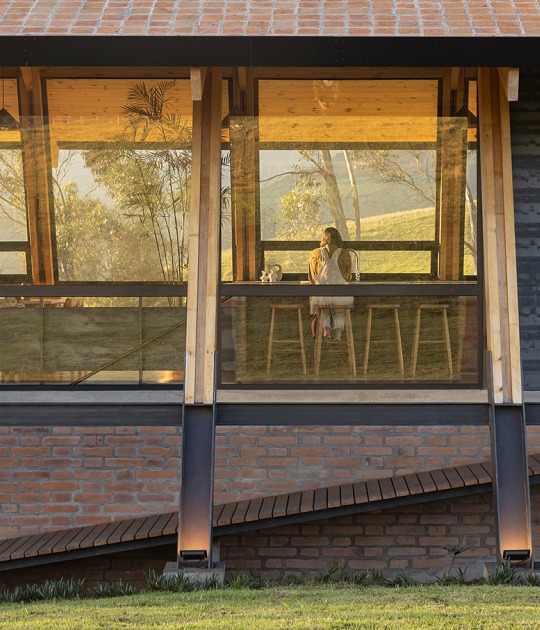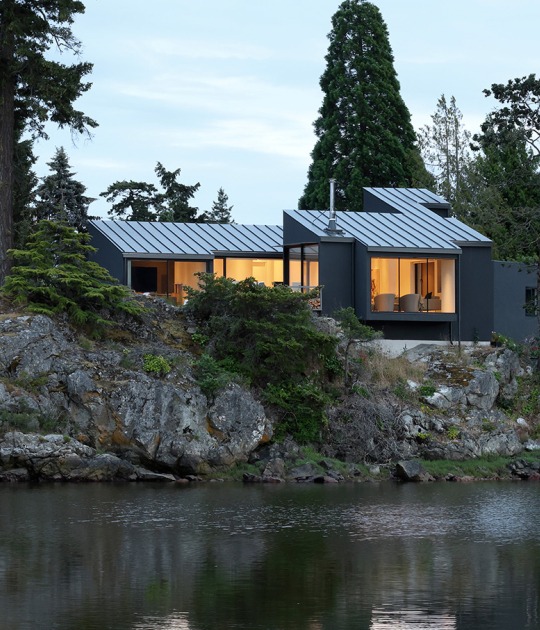The situation of the Paupys Yards project generated a light problem, between the existing trees around the river, together with the orientation it resulted in the design of those patios, which seek to open up and receive natural light into the corrugated patios.
The design of the roof also dialogues with the river slopes, generating a simile, the architecture studio is aware that it will intervene in the environment and will condition it, therefore it seeks to integrate and adapt.
Description of project by Arches
By fostering a hundred years of traditions of living in the remarkable historical city of Vilnius, where the expressive environment and man-made architectural ensemble, were combined, the creation of a unique residential urban-architectural park, was started. It is UNESCO-protected area, located in the Old Town of Vilnius Lithuania, where the industry has existed for many years, in the valley of the Vilnelė River, which stands out on its slopes combined with specific characteristics, and constraints while offering residents an exceptional quality, of life. The new district was divided, into separate quarters, which were designed by different architectural offices from Lithuania. The Riverside courtyard quarter becomes like a gate, a transition from the old city to the newly shaped part. There-fore, while developing concept design, we concentrated on synergetic interfaces and in-terconnection with the environment and human, we aimed to use its unique features of the existing site. One of the exclusive characteristics of the Old Town is the gabled A shape roof - the multi-faceted silhouettes formed by it, harmoniously merging with the hills and river slopes and bends. We also applied this feature in our designed complex, where the undulating outlines of the volumes pass to each other in ascending curves, moving away from the old town and the river.
The second exceptional morphological characteristic of environmental spaces is the ir-regularly shaped system of courtyards, which allows having closed, safe community spaces even in the densely built-up area. The latter feature became not only the leitmotif of the interiors of our quarter but also gave the name of the quarter - Riverside courtyards.
The third feature of the site is the adjacent green slopes of the river and the proximity of the river itself. We believe that such elements in the city centre should not be hidden, or not utilized, so the creation of the residential complex has consistently followed the provi-sion to open the views of the main urban street spaces to the green massifs. Space gaps were left, between the buildings, where we formed the perimeter of the street with clear glass walls-joints that allowed to create private spaces for the residents’ courtyards while opening up views of the river to all the townspeople.
The fourth environment feature is the light and its position of compound world direc-tion. The site territory is located, on the river slopes, which is overgrown with old trees, and it creates a light problem. Also, the river is on the Northside of the site, so it generates conflict between open views to a landscape in the North, natural light and city streets in the South. So we introduced an option of transverse space system that allows natural light to interact within interior spaces, as well as, beautiful views of courtyard and street throughout the entire area.
The dichotomy of cosy light, the interior of a quiet neighbourhood and the exterior of in-tense public life in the surrounding streets are also coded, in colour and textured façade solutions: courtyards are made, of ultra-bright 3D bricks that help maximize the amount of dark light, dulcet bricks that create the impression of a monumental, sustained, forming an idea of the self-preserving quarter. This dichotomy is also recorded, in the composi-tions of façade windows, where these elements in the external façades are arranged in a remarkably organized manner, maintaining a strict rhythm, and the windows in the inner courtyards are independent compositions.
The complex consists of six separate buildings that have courtyards in between. The height of the buildings increases as you move away from the Old Town, along the main street pavement. Similar reasoning was maintained, concerning the river: the building structures near Vilnelė are lower, it repeats its bends as it moves away, approaching the main street - the volumes expand. It ensures harmony and silhouette of the residential complex within the environment, that opens the views of the river and Old Town, to the residents or guests residing in the depths of the quarter. Fractures in courtyard volumes not only help to create spatial arrangements that indicate the relationship between the environment but are strictly motivated by insulative calculations. The turning angle of each façade plane must maximize the amount of coming light, as well as open views of existing landscape and church towers.
The resident cars of the whole complex stored, in underground car parks situated under plots, all courtyards are designed only for residents, green areas and playgrounds. Each yard are divided into separate spaces that form functions for different purposes, thus tak-ing care of the interest of all residents: spaces for recreation for the elderly, urban farming zones, playgrounds and private terraces (for the residents of the first floors), are provided.
By adapting variable-height retaining walls, allows designing a hilly relief, that mirrors a characteristic of the existing environment combined with an ensemble of the structure, as a whole composition. All apartments in the complex, have terraces, or recessed balconies, so not only the integrity of the volume is maintained, but the privacy of the residents, is ensured. To monumentalize the structure volumes chimneys are hidden, in technical shelters, cornices of rainwater pipes created, roof cladding tiles connected and merged with the texture of the façade.
It allows creating an organically pulsating, cohesive architectural ensemble visible in the most valuable panoramas of the city, combining almost all possible attributes necessary for a person: nature, private space, places of socialization, work areas, direct connection with history.
































































